Guest post by Robin Agarwal
This is the fourth post in our Sea Slug of the Month series. Find tips for spotting nudibranchs from the comfort of your local dock at the end of this post!
So you’ve been tidepooling along your local reefs and you’ve found a few nudibranchs: Opalescents, Sea Lemons, Spanish Shawls, Hopkins’s Rose, Triophas. Maybe you’ve practically tripped over ginormous squishy Sea Hares. Boring, right? What a snooze, all those flamboyant colors, shapes, and bizarre anatomy. After all, those nudibranchs are over an inch long, and therefore way too easy to find.
If this is you, clearly it is time for you to up your game with a new challenge. Welcome to “The Smalls,” a casual selection of California sea slugs that are defined not by taxonomy, but by their minute size, cryptic coloration, and general near-impossibility to find. They’re well under an inch long, and they’re beige (with a few colorful exceptions). They may even be seasonal, spending only a few months of the year in their adult form the only form really visible to the human eye. The good news is that once you know what to look for, you’ll be able to find them, often in large numbers, often in improbable places.
Dotos
Dotos are very tiny nudibranchs with inflated, tubercled cerata (the digestive structures on their backs). Their adult size is usually less than 15 mm long. They feed only on specific hydroids and adopt the coloration of their prey. It is often easiest to spot a Doto by first noticing the presence of small, white egg masses on those preferred hydroids. In California, we have four described species of Dotos and one so-far undescribed species:
Doto amyra (Hammerhead Doto) is a pale Doto with no dark markings on its body. Its cerata are variable in color from white to pink. Probably the most often-seen Doto in Central California, it can be found feeding on thecate or athecate hydroids.
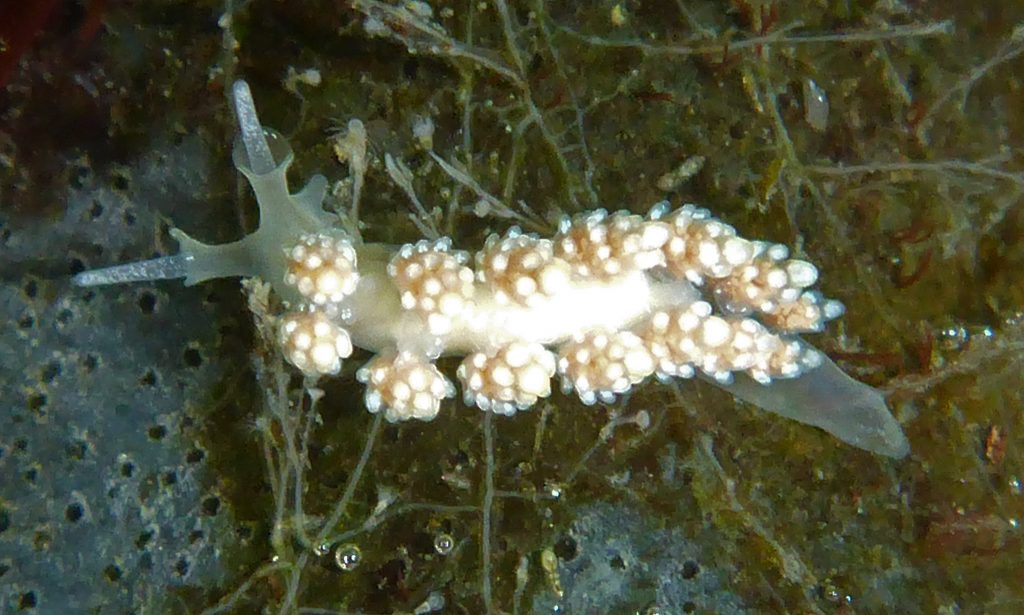
Doto columbiana (British Columbia Doto) is a beige Doto with brownish, leopard-like markings on its body that extend all the way down to its foot. Its cerata are often curled slightly over its back and appear to ‘glow.’ It is also fairly common, feeding on feathery-looking brown hydroids from the genus Aglaophenia.
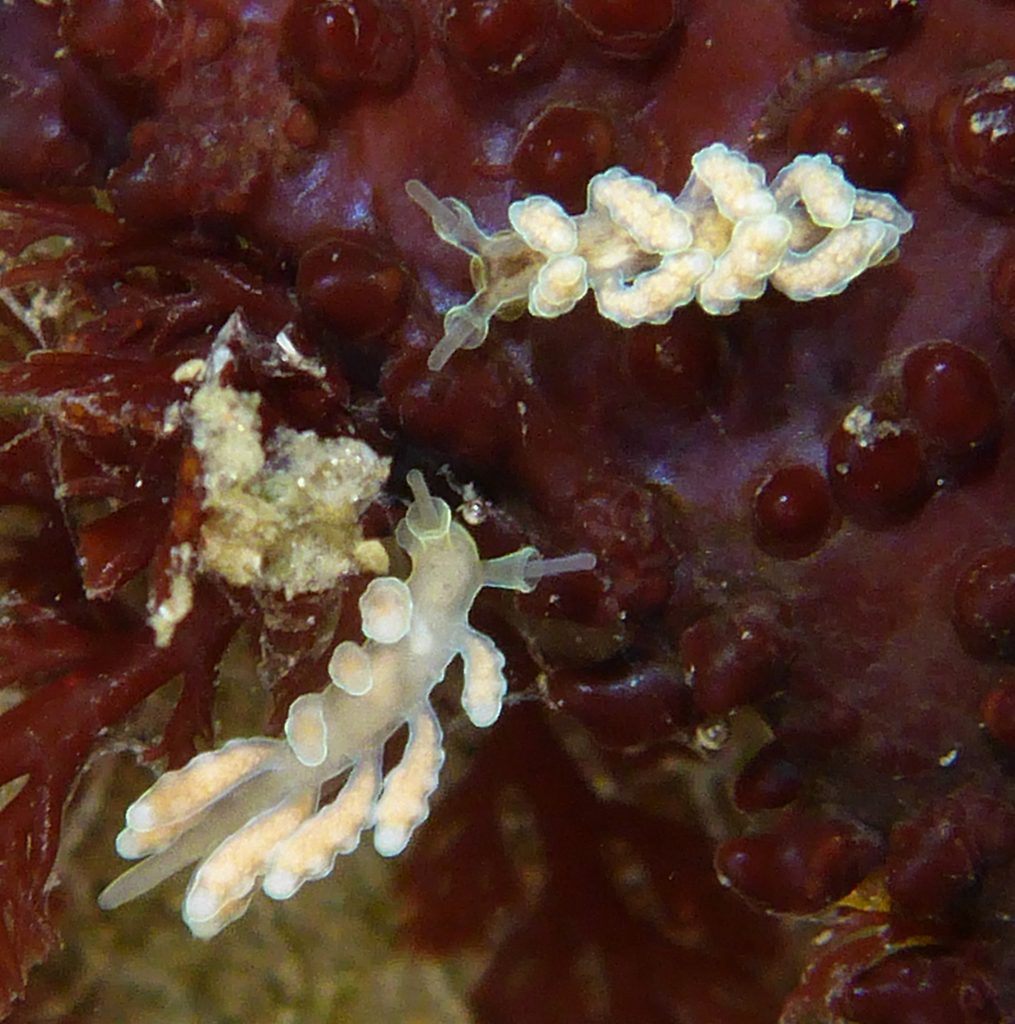
Doto kya (Dark Doto) is a piebald Doto with variable black markings on its mostly-white body that do not extend to its foot. Like D. amyra, its cerata color is variable white through pink. Its rhinophores may have small opaque white spots. D. kya prefers Plumularia hydroids.
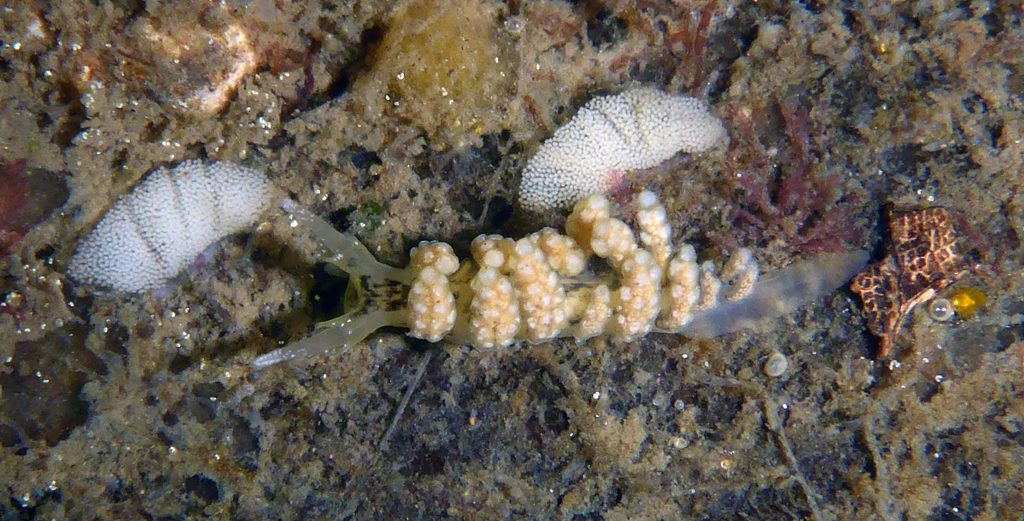
Doto lancei (Lance’s Doto) is a rarer Doto, with dark brown or black pigmentation on its body and head that extends up through the rhinophore sheaths.
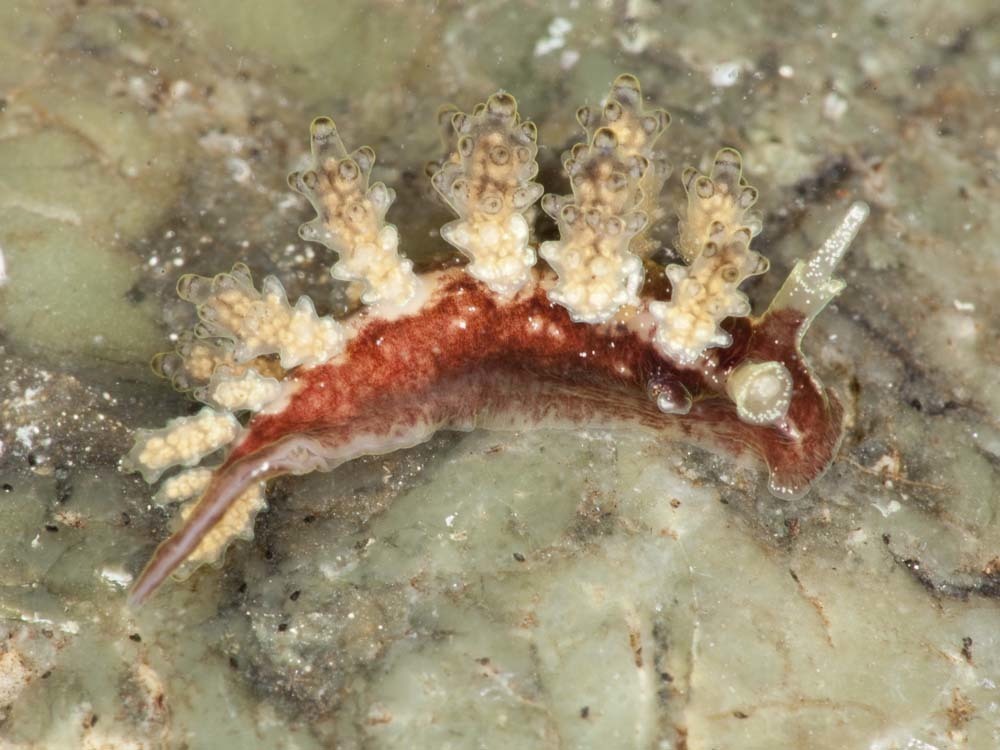
Doto Form A of Goddard, 2014 (no common name yet)—is an undescribed, but apparently common, white-bodied Doto very similar to D. amyra. Its lumpy pinkish cerata are covered with white-tipped tubercles, resembling small pink raspberries with white seeds. Its rhinophores have a prominent cup-shaped sheath and are tipped with opaque white.
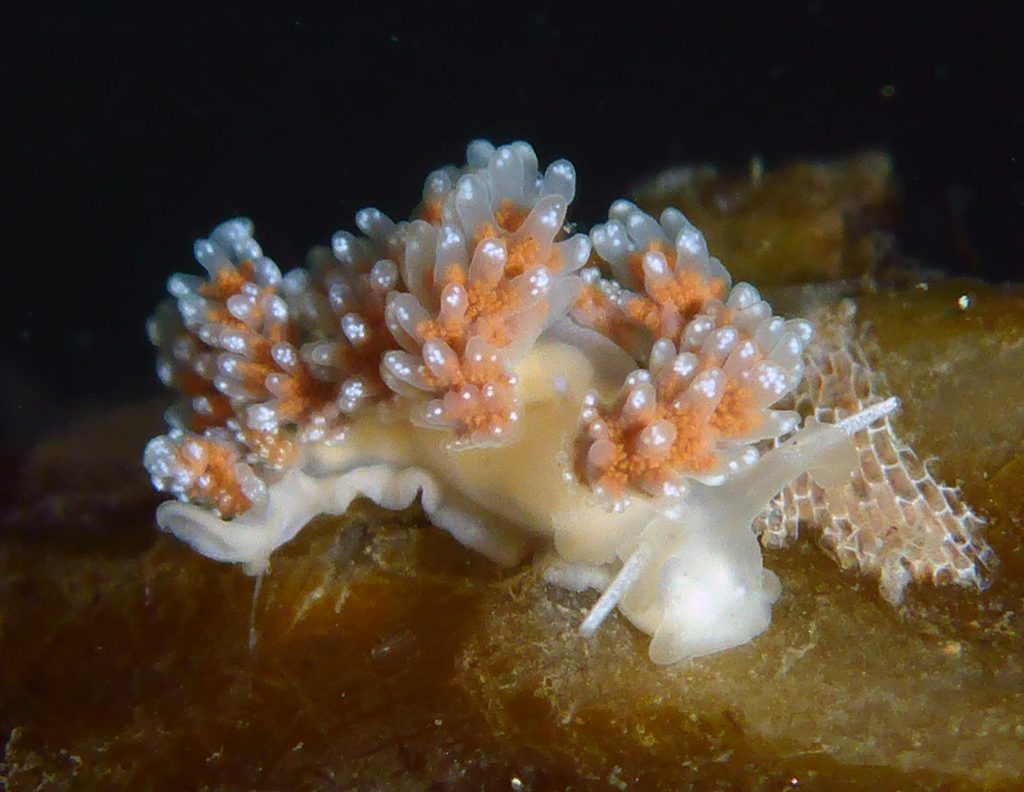
Eubranchus
Eubranchus are even smaller than Dotos, topping out at only 7 mm long. Eubranchus are a taxonomically challenging group of nudibranchs, with at least one California species and maybe more, depending on taxonomical changes. Eubranchus rustyus (Homely Aeolid) has a pale body with mottled olive or brownish markings that extend all the way down its foot. Its rhinophores are tipped with white, and have a dark brown band. Its short oral tentacles also have brown bands. This sea slug prefers Obelia and Plumularia hydroids, and can sometimes be seen in large numbers feeding and laying eggs on them.
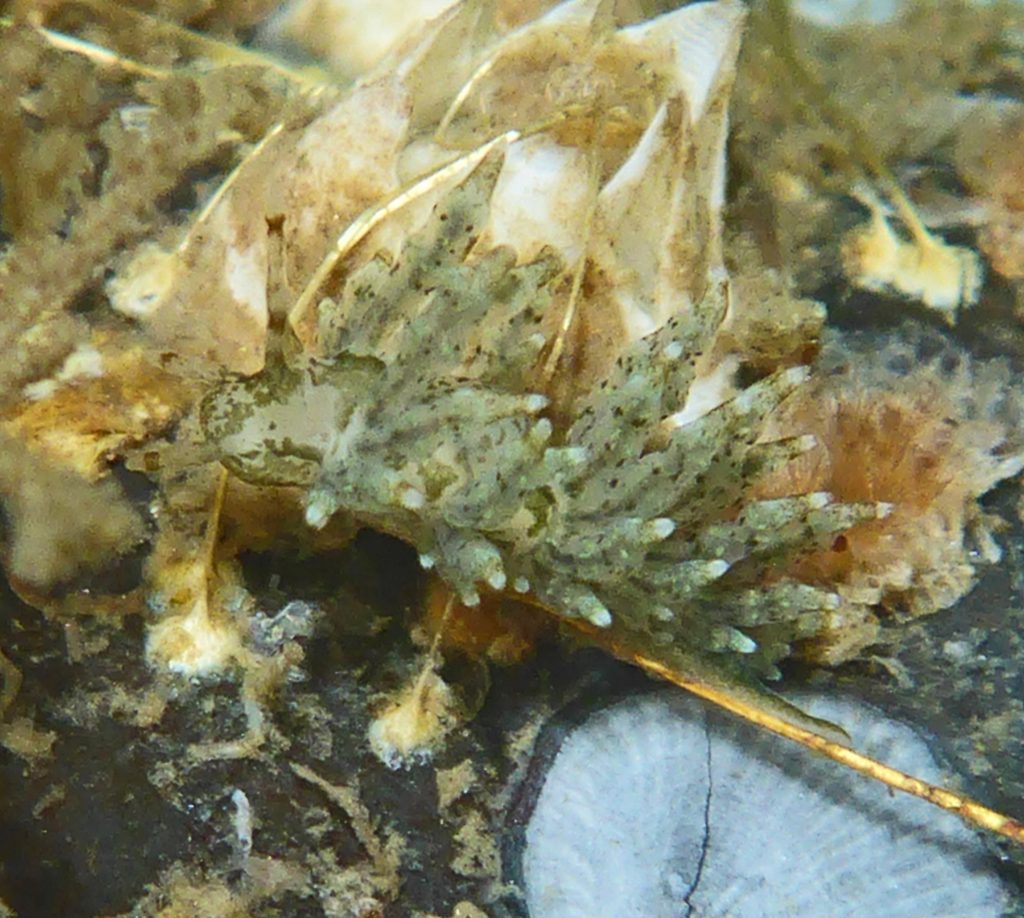
Related to Eubranchus, and formerly included in that genus, is Leostyletus misakiensis (Misaki Aeolid). This invasive from Japan has small brownish polka-dots all over its body. Its rhinophores, oral tentacles, and tail have a few opaque white speckles. Slightly larger than E. rustyus, the Misaki Aeolid is mainly found in the San Francisco Bay, munching on Obelia, but may occur in other harbors where conditions are suitable.
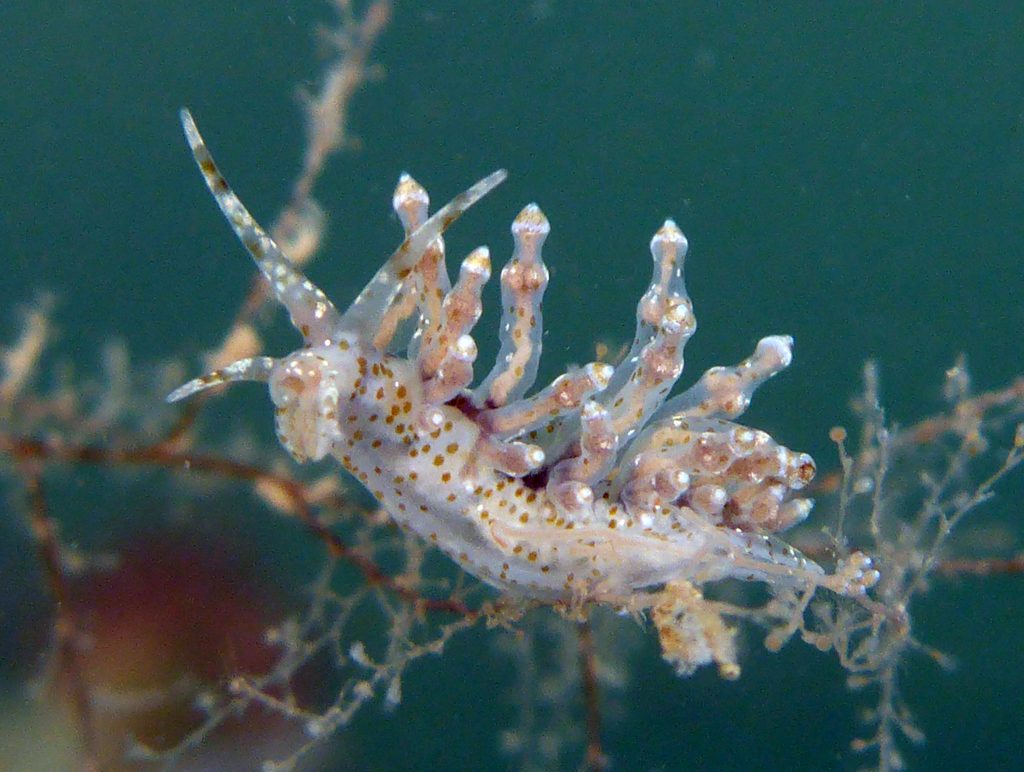
Two other “Smalls” first found in Southern California harbors
Two other cryptic “Smalls” derive their species names from the Southern California harbors where the first specimens to be described were found. Both are found in Central California harbors as well:
Okenia angelensis (Los Angeles Okenia) is the small, drab cousin to the outrageous, bubble-gum pink Okenia rosacea (Hopkins’s Rose). The maximum length of O. angelensis is only 12 mm, and their fine brown speckling and short papillae help them blend in with their surroundings. Look for their white egg masses to lead you to them!
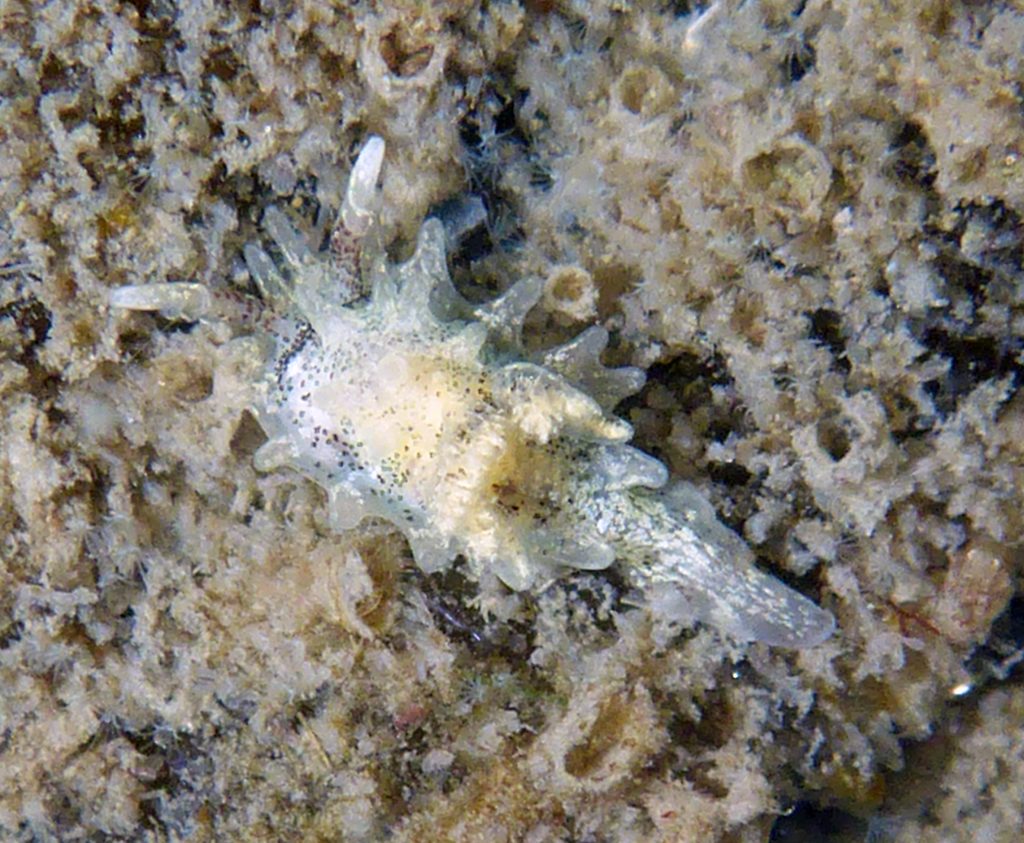
Emarcusia morroensis (Morro Bay Aeolid) is an uncommon species, with a pale body with a few opaque white speckles and white-tipped oral tentacles and rhinophores. Its cerata are banded in brown and black. It has two small orange spots near its rhinophores on its “head.” This species grows to 14 mm, though most I’ve seen are about half that length.
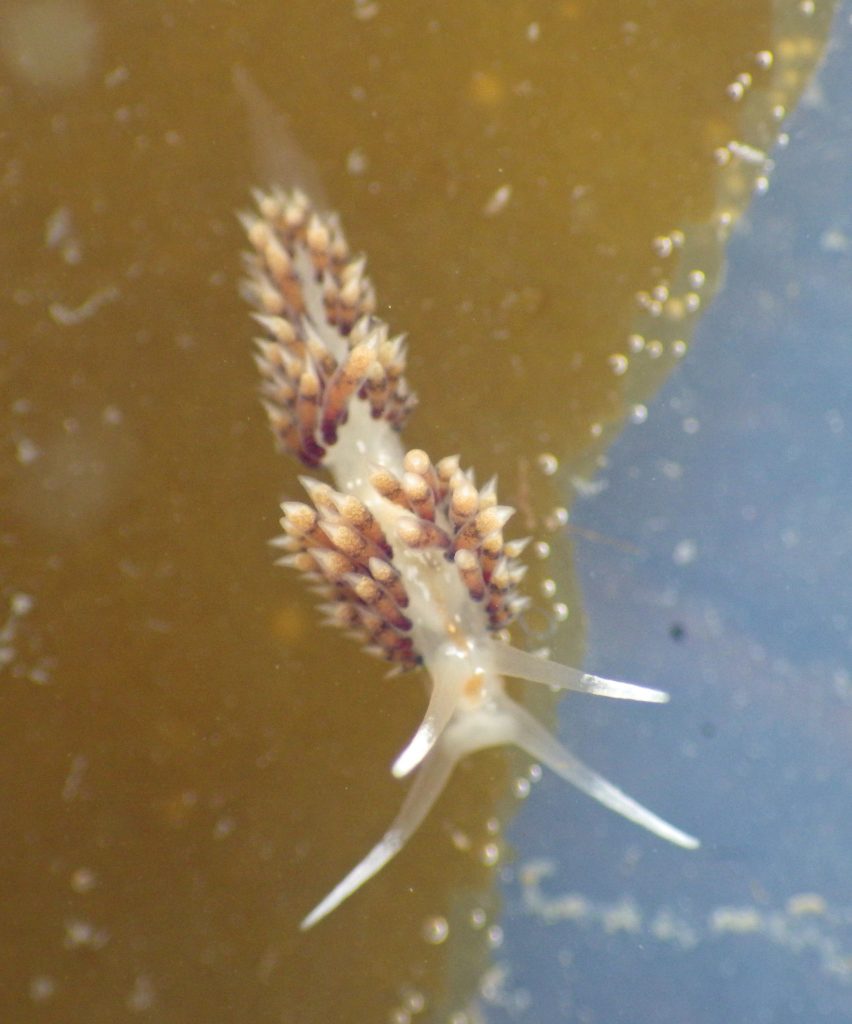
While you are out looking for these difficult-to-find nudibranch species, you will doubtless encounter juveniles of many of the larger nudibranch species as well. That’s just keeping it interesting! For help with IDs, consider posting your photos on iNaturalist.org, or use iNaturalist’s free online guide to California Nudibranchs (disclaimer: I’m one of its curators, and I like to keep the taxonomies current, so if you see any mistakes, please let me know!). If you’re looking for a tangible field guide, I use Eastern Pacific Nudibranchs (2005) by David W. Behrens and Alicia Hermosillo.
No Scuba AND No Low Tide, Still No Problem: Where to See a Nudibranch, Part 2: Dock Fouling
If you are fortunate enough to have access to a floating dock in a harbor or marina, you may be able to spot nudibranchs and other interesting dock fouling marine life at any time of the day, since this artificial habitat is not susceptible to the vagaries of tides. Public boat ramps, kayak docks, and other floating structures are often home to a surprising variety of sea slugs that prey on the sponges and bryozoans encrusting the sides and undersides of these structures.
WARNING: It is critically important that you ensure that you are not trespassing; many marinas and docks are private, and some boat owners do not take kindly to folks wandering around without permission. One bad actor can spoil it for everyone!
Once you indeed do have permission to take a look, lay down on the dock with your head hanging over the side and examine the sides of the dock. You’ll see anemones, algae, barnacles and other molluscs, small fish, and all sorts of interesting sea life. If it is nicely grungy, you may get lucky and see a nudibranch. (Insider tip: lay on a towel in case of gull poop.) Gently move aside algae as needed, but do not remove anything, since this habitat is surprisingly fragile. Pier pilings are also a good place to look, since nudibranchs can crawl up from below.
As with intertidal nudibranch hunting, GO SLOW. These beasts are small and it takes plenty of patience to find the tiny/beige/cryptic species. If you see one, leave it where it is, since it has somehow found food in this dock location.
Good luck!
Guest Author, Robin Agarwal
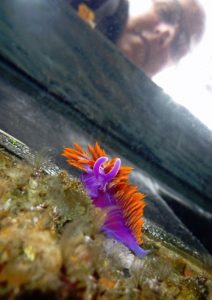
Lying flat on a bouncing floating dock underneath one of the biggest tourist-attraction piers in California, with my head and arms hanging over the side, I am frequently reminded of the kindness of fellow humans who think I’ve had a stroke or dropped my phone. No—just photographing sea slugs! I point, and show them a few photos on the back of my cheap underwater macro camera, and presto, another nudibranch enthusiast.
I was a tidepool kid who went astray and graduated with a liberal arts degree. In the last decade, I’ve returned to the tidepools and found a particular passion for photographing nudibranchs and other intertidal marine life. I’m co-editor of the California Sea Slugs Guide, and the Dock Fouling in California project on iNaturalist.org, where I have posted about 4,000 geotagged observations of nudibranchs, mostly along the Central California coast. Since I offer all my photos free to non-profit organizations (my way of thanking them for the work they do), you can find them all over the internet as well as Bay Nature magazine and NOAA National Marine Sanctuary informational signage. I’ve also been an enthusiastic contributor to a few scientific papers on nudibranchs, most recently Heterobranch Sea Slug Range Shifts in the Northeast Pacific Ocean Associated with the 2015-16 El Nino by Goddard et al. (2018).
Subscribe to our weekly blog to have posts like this delivered to your inbox each week.
Help us protect and restore the Morro Bay estuary!
- Donate to the Estuary Program today and support our work in the field, the lab, and beyond.
The Estuary Program is a 501(c)3 nonprofit. We depend on funding from grants and generous donors to continue our work. - Support us by purchasing estuary-themed gear from ESTERO. This locally owned and operated company donates 20% of proceeds from its Estuary clothing line and 100% of Estuary decal proceeds to the Estuary Program. Thank you, ESTERO!
- Purchase items from the the Estuary Program’s store on Zazzle. Zazzle prints and ships your items, and the Estuary Program receives 10% of the proceeds. Choose from mugs, hats, t-shirts, and even fanny packs (they’re back!) with our fun Estuary Octopus design, our classic Estuary Program logo, or our Mutts for the Bay logo.